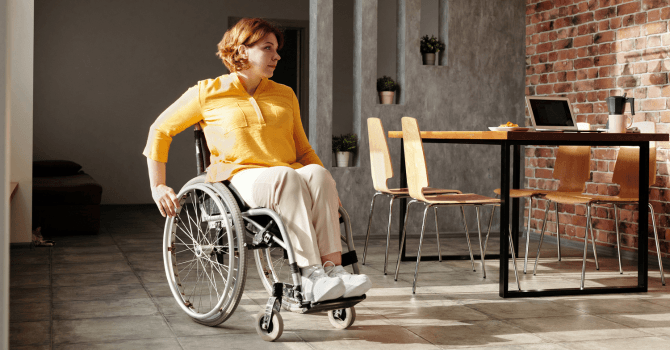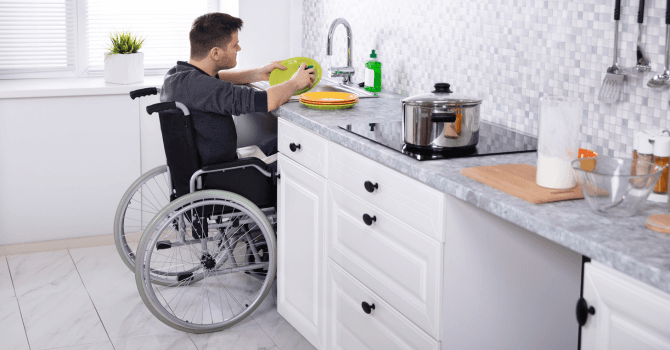Home Adaptations for Mobility-Impaired Individuals
By Editorial Team
Updated on March 24, 2025

Anyone who lives in an environment that doesn't suit their needs when it comes to mobility or comfort will be subject to a great deal of frustration. To ensure a comfortable and pleasant living environment for an individual with reduced mobility, here's a look at the renovations to take on.
Adapting a home for a person with reduced mobility

Source : Canva
Initial considerations
When it comes to living with persons who have reduced mobility, it’s crucial to consider ways to improve the quality of living for your loved one. This comes down to questions of how to adjust living areas to compensate for any sensory loss or physical limitations. This doesn’t always require a complete remodel to your interior spaces, but some changes do need to be made. Here are some initial considerations for renovating your home to accommodate those with reduced mobility:
This project isn't necessarily expensive: There are plenty of low-cost changes that you can make to help those with reduced mobility, these include replacing cabinet knobs with easy-access pull bars, adding night lights along the stairwells, increasing bulb wattage, installing bars in the bathroom and entryway, removing old, slippery rugs or bath mats, and regulating water temperature to avoid injury. Of course, some of the bigger jobs are on the pricey side, so do make sure to plan a budget for this project.
Reduce glare around the home and increase lighting: One of the most basic modifications you can make to improve interior spaces is to make sure they’re well lit. If possible, paint interior walls with glare-free paint, making sure ceilings are white to reflect and disperse light in the space. Floors should be dull and avoid waxing, as this creates a slippery environment. Install extra light fixtures in rooms lacking in natural light and as mentioned, along any ramps or staircases. For other spaces, like the bathroom and kitchen, consider task lighting.
Keep spaces uncluttered: Making sure to have clean and visible surfaces is very important when living with persons with reduced mobility. There should be plenty of space in each room to move around freely, with nothing obstructing clear pathways and not too much to bump into. Any unnecessary furniture should be donated or sold. Think minimal pieces with maximum functions, like multi-purpose furniture.
Renovating the kitchen

Source : Canva
In the kitchen, it's recommended that you install height-adjustable furniture. With adjustable furniture, it'll then be possible to adapt the level of workspaces as well as the height of each piece of furniture. If this is not a feasible option due to budget or location, opt for facilities that are low enough to be accessible at all times and to those with reduced mobility or in wheelchairs.
If the layout of the home allows, your dishwasher and fridge should be raised about 80 centimetres to prevent their opening from being blocked by the wheelchair. The sink, with front or side access, must be equipped with shallow bins to allow sufficient space for a wheelchair to pass. Thus, it will not be necessary to work at arm's length.
Another quick note regarding the kitchen, but one for all rooms of the home, is to install rocker-style push light switches. This style switch is much easier to use than our traditional toggle or flip switches since they’re bigger and need less effort to operate.
Bedrooms and doors
Regarding choosing the bed, it's recommended that you choose one with a relatively low height in order to be able to slip in and out without having to stand or rise to the height. A space of 90 centimetres should be left on each side of the best, and a minimum space of 120 centimetres between the end of the best and the door (when it’s open). Regarding the dimensions of the bedroom doors, they should have a minimum width of 83 centimetres.
Rethinking the entrance
On the other hand, the entrance door must be at least 103 centimetres wide. It's recommended that you place the doorbell and lock at face height to avoid your loved ones stretching every time they want to get inside.
Further, the installation of a ramp is essential. At this level, it would be better to prioritize models with straight lines rather than models with curves, as the latter requires the execution of difficult maneuvers in a wheelchair. The sections of the ramp should never exceed 9 meters, with a maximum of 6 meters to be prioritized if the person using it is particularly weak.
A long ramp will need bearings in order not to subject its' user to excessive amounts of physical effort. Please note that this is a measure that is able to provide detailed information on the precise dimensions to be followed so that the ramp is of regulated measure.
Adaptions to be made to the whole house

Source : Canva
It should be noted that it's advisable to avoid carpets throughout your home, as they'll make the passage of a wheelchair quite difficult. As we mentioned in our introduction, in all rooms, it's necessary to leave a central space of a meter and a half, free of furniture or objects. This will allow for the free movement of the wheelchair.
When choosing cabinets and drawers, opt for sliding models. Drawers will be easier to open and cabinet doors will be less cumbersome when opened. Then, it'll be possible to search cabinets without constantly needing to move back to the chair to prevent it from blocking the opening.
The Housing Adaptation Program of the Société d'habitation du Québec
As mentioned on the website of the Société d'habitation du Québec, the home adaptation program allows an individual whose permanent physical impairment jeopardizes the accomplishment of daily activities to receive a subsidy for the adaptation and renovation of their homes to suit their physical needs. To be eligible, you must meet the following two conditions:
1- You must be able to provide a report produced by an occupational therapist attesting to the permanence of the impairment as well as the need to make changes to your home or apartment.
2- You must not be eligible for financial assistance under the insurance plans for the Société de l'assurance automobile du Québec or the Commission for Occupational Health and Safety. It should be noted that the maximum amount that can be allocated is $16,000 and it is unlikely to cover the full costs required to complete the work. The difference will need to be provided by the owner. Note that it is imperative to undertake the work after the approval of the Société d'habitation du Québec to be eligible for the grant.
Alberta’s RAMP program

Source : Canva
In the province of Alberta, if you or a loved one is a low-income individual with mobility issues, you’ll be able to apply for the Residential Access Modification Program or RAMP. This subsidy is granted to Canadian citizens or Alberta residents who use a wheelchair or live with progressive neurodegenerative disease. The government offers up to $7,5000 per person. For detailed information, take a look at the Alberta.ca website.
Nova Scotia’s Disabled Residential Rehabilitation Program
The province of Nova Scotia offers forgivable loans to homeowners in amounts of up to $16,000 towards renovations for making a permanent residence more accessible. This subsidy is given to low-income individuals for projects that improve access and use of basic facilities.
There is also a specific grant available for those confined to a wheelchair, with up to $7,000 awarded to pay for accessibility modifications. You can find detailed information about these grants on the Housing Nova Scotia Website.
Ontario Renovates Program
This program will offer forgivable loans up to $20,000 for low-income individuals who own and occupy a dwelling that needs accessibility modifications. This can include making modifications to heating and cooling systems, furnaces, leaking basements, doors, windows, foundations, electrical and septic systems, and so forth. This program is determined by the city. So for more information, visit your city website like this one in Ottawa.
Get 3 renovation quotes for your home adaptation project
RenoQuotes.com can help you get quotes for your home adaptation project. If you submit your project to us, we’ll put you in contact with top-rated contractors. Fill in the form on the homepage (it only takes a few minutes), and you will receive quotes from companies that are specialized in home renovations.
Dial 1-844 828-1588 to speak with one of our customer service representatives
Looking for something else?
Related articles
The latest industry news, interviews, technologies, and resources.

Editorial Team
•07 Nov 2023
Small rooms in the home require ample planning in order to set the right tone. Lighting is an integral part of this process, as excellently designed and placed lighting and fixtures can help a space to really shine.
Editorial Team
•23 Jul 2025
Caulking can be defined as the process of sealing or filling gaps, done to prevent leaks and drafts. To do so, numerous caulking or weatherizing products are developed and often sold in retail stores as caulks, sealants, or mastics. They’re made with butyl, silicone, urethane, acrylic, or even latex, and said material diversity makes it all the more difficult to choose the right product.

Editorial Team
•07 Nov 2023
Buying a house is probably the single most important financial investment of a lifetime. Therefore, a future homeowner should be assured of paying a fair price for their new property and avoid being confronted with unforeseen work and the costs that come with it.

Amanda Harvey
•07 Nov 2023
With the advancement of technology, and with many jobs becoming digitized, it's growing more common for people to work from the comfort of their home. Whether you’re a new mother raising a baby while trying to meet deadlines or a person who has decided to branch out and bring that new business venture to life, having an efficient and relaxing home office will allow you to maintain productivity and get the most out of life.

Cynthia Pigeon
•07 Nov 2023
A building's structure is either made of wood, concrete, or steel. To finish this structure and give a business, facility, or home an eye-catching look, opting for masonry siding is a definite possibility. And, a bricklayer-mason hired by a contractor will be qualified to carry out this type of project.